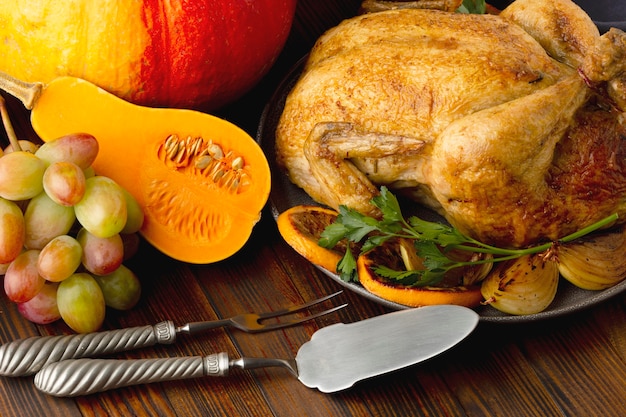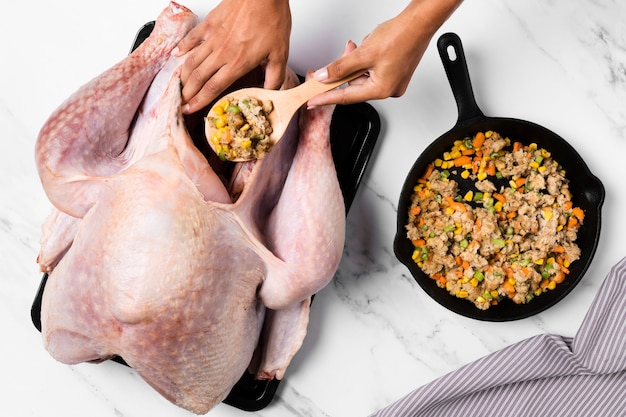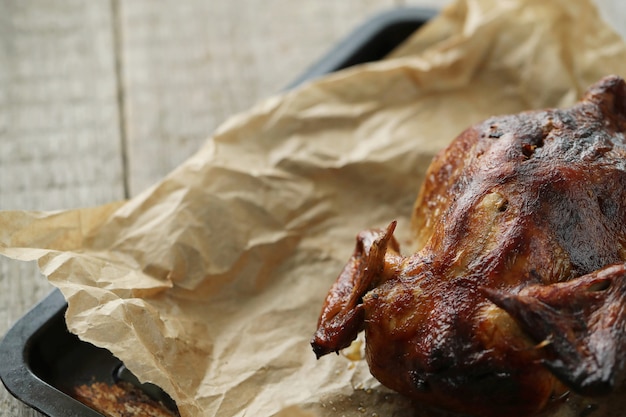Let’s talk about roast chicken, a dish that's always a crowd-pleaser. It's so versatile; you can serve it up with a variety of sides and it always looks impressive, even if you’re not a seasoned chef. I’ve been making roast chicken for years now, and I’ve picked up a few tricks along the way. I’m not talking about fancy, Michelin-star stuff, just simple, delicious chicken that's perfect for a family dinner or a casual get-together with friends. So, grab a cuppa, get comfy, and let's get started!
(Part 1) Choosing Your Bird: The Foundation of a Great Roast

You can’t have a perfect roast chicken without the perfect bird. And believe me, there’s a big difference between a good bird and a great one. I’m a big fan of free-range chickens. They've had a better life, and you can really taste the difference. When choosing your bird, look for one that's plump and has a good amount of fat under the skin. This will keep the chicken moist and juicy during cooking. I always try to get a chicken that's around 1.5 kg (3.3 lbs), as this is a good size for a family of four. If you're cooking for more people, just adjust the size accordingly. And don't be afraid to ask the butcher for advice. They're usually happy to help!
Choosing the Right Breed: Making the Most of Your Bird
There are lots of different breeds of chickens out there, and some are better suited for roasting than others. Here are a couple of my favourites, each bringing something unique to the table:
- Cornish Cross: These chickens are known for their fast-growing, meaty legs and breasts. They are a good choice if you want a juicy, tender roast chicken. Think of this as your go-to for a classic, succulent roast experience.
- Red Broiler: A classic choice, these chickens are bred for their fast growth and are a good all-rounder, offering good flavour and texture. They are the perfect choice if you are looking for a well-rounded flavour and a bit of versatility in cooking methods.
Ultimately, the best breed for you will depend on your personal preferences and what you are looking for in your roast chicken. Do you prefer a more robust flavour or a tender and juicy result? It’s up to you, and exploring different breeds is a great way to discover what you like best.
(Part 2) Preparing the Chicken: Setting the Stage for Success

Okay, so you’ve got your bird, now it's time to get it ready for the oven. The first thing I do is give it a good wash inside and out. I find that rinsing it under cold water helps to get rid of any leftover feathers and makes the skin nice and clean. Then, I pat it dry with kitchen paper. You want to make sure the chicken is dry before you start seasoning it, otherwise, the seasoning won't stick properly.
Seasoning the Chicken: A Symphony of Flavors
Now for the fun part - the seasoning. I'm a firm believer in keeping things simple. A good quality olive oil, a generous sprinkle of salt and pepper, and maybe some herbs if you're feeling fancy. I like to use fresh rosemary and thyme, but you can use any herbs you like. Rub the seasoning all over the chicken, making sure you get under the skin as well. This will help to flavour the meat and give it a beautiful golden colour when it's roasted.
Here's a little tip: If you want to add a bit more flavour, try stuffing the cavity of the chicken with some aromatics. A couple of lemons cut in half, some garlic cloves, or even a handful of fresh herbs will work wonders. Just make sure you don't overload the cavity, or it might make the chicken too moist and difficult to cook. Adding these aromatics to the cavity infuses the chicken with a delightful aroma and adds a layer of complexity to the flavour.
(Part 3) Roasting the Chicken: The Journey Begins

Time to get the oven going! Preheat it to 190°C (375°F) for a good 15 minutes. This will ensure the oven is nice and hot, which is essential for getting that crispy skin. While the oven is heating up, I like to prepare a roasting tin. I usually line it with baking paper for easy cleanup later. Place the chicken in the roasting tin, breast side up. Now, for the magic ingredient...
The Importance of Basting: The Key to Juiciness
Basting is the secret to a juicy, flavorful roast chicken. It's simply the process of spooning melted fat, juices, or other liquids over the chicken while it's cooking. This keeps the chicken moist and helps to create a delicious golden-brown crust. You can use butter, olive oil, or even chicken stock for basting. I usually use a mix of butter and olive oil. You want to baste the chicken every 20-30 minutes during cooking. Just use a spoon or a baster to pour the melted fat and juices over the chicken. Trust me, it's worth the effort!
Basting isn't just about moisture, it's also about flavour. As the chicken cooks, the juices and fats collect in the roasting tin, creating a flavorful base. By basting with these juices, you are constantly adding back that flavour and enriching the chicken. It’s a simple yet powerful technique that makes all the difference.
(Part 4) cooking time and Temperature: Navigating the Heat
Okay, so the chicken is in the oven, the basting is happening, now it's time to talk about the cooking time. I always say, it's better to err on the side of caution and cook the chicken a little longer than it might need. I normally cook a 1.5 kg (3.3 lbs) chicken for about 1 hour and 15 minutes, but always check it's cooked through using a meat thermometer. You want the internal temperature of the chicken to reach 74°C (165°F) to ensure it's safe to eat. Make sure you insert the thermometer into the thickest part of the thigh, not just the breast. If the chicken isn't cooked through, just pop it back in the oven for another 10-15 minutes.
Resting the Chicken: The Finishing Touch
Once the chicken is cooked, it's essential to let it rest for at least 10 minutes before carving. This allows the juices to redistribute throughout the meat, making it even more tender and juicy. I usually cover the chicken loosely with foil to keep it warm while it's resting. This is a crucial step that often gets overlooked, but it makes all the difference in the final outcome.
(Part 5) Serving Up the Roast Chicken: The Grand Finale
After that satisfying wait, it's finally time to enjoy your delicious roast chicken! Here's a simple yet effective method for carving it:
Carving the Chicken: Unlocking the Flavors
1. Remove the legs: Using a carving knife, carefully cut between the leg and the body, then lift the leg away.2. Remove the wings: Similar to the legs, cut between the wing and the body. Feel free to separate the wing at the joint for easier serving.3. Carve the breast: Starting at the neck end of the breast, slice the meat into thin slices. You can also remove the breastbone for easier carving.
Serve the chicken with your favourite sides. I love mashed potatoes, roast vegetables, and gravy. You can even make a delicious chicken stock from the pan drippings. But, you know, it's really up to you! Just get creative and have fun with it!
(Part 6) Roast Chicken Variations: Beyond the Basics
Now, let's talk about some different ways to spice things up with your roast chicken. You don't have to stick to the basics, you can get creative and experiment with different flavours and techniques. Here are a few ideas to get you started:
Spiced Roast Chicken: A Journey of Flavors
Why not add a touch of exotic flavour to your roast chicken? Try rubbing the chicken with a spice paste made with garlic, ginger, chilli, cumin, and coriander. You can also add some lemon juice for a citrusy twist. This will give your chicken a fragrant and aromatic flavour profile. This is a great option for those who love bold flavours and are looking to explore different culinary traditions.
Lemon and Herb Roast Chicken: A Classic with a Twist
This is a classic for a reason. Simply stuff the cavity of the chicken with lemons cut in half and a bunch of fresh herbs like rosemary and thyme. This will create a fragrant and aromatic chicken that is sure to impress. You can also add a drizzle of honey for a touch of sweetness. The combination of lemon and herbs creates a bright and refreshing flavour that complements the chicken beautifully.
Garlic and Herb Roast Chicken: Simple Yet Delicious
For a simple and flavourful roast chicken, try rubbing the chicken with a mixture of garlic, herbs, and olive oil. This will create a delicious, garlicky chicken with a hint of freshness. You can use any herbs you like, but I recommend using a mix of rosemary, thyme, and parsley. The simplicity of this variation allows the natural flavours of the chicken to shine through, while the garlic and herbs add a touch of complexity.
(Part 7) roast chicken sides: The Perfect Companions
A roast chicken is only as good as its sides. And let's be honest, the sides are often the real stars of the show. Here are some classic roast chicken sides that are guaranteed to please:
Mashed Potatoes: Creamy Comfort
You can't go wrong with creamy, buttery mashed potatoes. Just peel and boil potatoes until tender, then mash them with butter, milk, and salt and pepper. You can also add other flavourings like garlic, chives, or even a little mustard. Mashed potatoes are a classic side for a reason; they are simple to make and provide a comforting and creamy texture that balances the richness of the chicken.
Roast Vegetables: Seasonal Delights
Roasted vegetables are a healthy and delicious way to complement your roast chicken. Try roasting root vegetables like carrots, parsnips, and potatoes. You can also add other vegetables like broccoli, cauliflower, or Brussels sprouts. Simply toss the vegetables with olive oil, salt, pepper, and any other herbs or spices you like, then roast them until tender and slightly caramelized. Roasted vegetables are a vibrant and flavourful addition to any roast chicken meal. They provide a variety of textures and colours, and their roasted flavours complement the chicken perfectly.
Gravy: The Perfect Finishing Touch
Gravy is a must-have for any roast chicken. To make gravy, simply deglaze the roasting pan with chicken stock or wine. Then, thicken the sauce with flour or cornstarch. You can add herbs, spices, or even a splash of lemon juice for extra flavour. Gravy adds a richness and depth of flavour that elevates the roast chicken to another level. It helps to bind all the flavours together and create a truly satisfying meal.
Salad: A Touch of Freshness
A fresh salad is a light and refreshing way to balance out the richness of the roast chicken and sides. A simple salad of mixed greens, tomatoes, cucumbers, and a light vinaigrette dressing will do the trick. You can also add other ingredients like onions, peppers, or cheese. Salad adds a burst of freshness and a touch of acidity to the meal, helping to cleanse the palate and make the roast chicken even more enjoyable.
(Part 8) leftover roast chicken: Turning Leftovers into Treasures
Don't throw away those leftover chicken bones! They're perfect for making a delicious homemade chicken stock. Here's how:
Making Chicken Stock: A Culinary Treasure
1. Place the chicken bones in a large pot.2. Add a few vegetables, like carrots, celery, and onion.3. Cover the bones with cold water.4. Bring the mixture to a boil, then reduce the heat and simmer for 2-3 hours.5. Strain the stock through a fine-mesh sieve.6. Use the stock for making soups, stews, or sauces.
And don't forget, you can also use the leftover chicken in sandwiches, salads, or other dishes. It's a great way to make the most of your roast chicken and prevent food waste.
FAQs: Clearing Up the Mysteries of Roast Chicken
So, you've been through my step-by-step guide, but maybe you've still got a few burning questions. Well, I've got answers!
1. Can I use a frozen chicken?
It's not ideal, but you can use a frozen chicken if you need to. Just make sure to thaw it properly before you start cooking. You can thaw it in the fridge overnight, or you can use the defrost setting on your microwave. Just be careful not to overcook the chicken, as it might dry out.
2. How do I tell if the chicken is cooked through?
Use a meat thermometer. The internal temperature should reach 74°C (165°F) in the thickest part of the thigh. If you don't have a meat thermometer, you can check the chicken by poking it with a fork. The juices should run clear, not pink. You can also look at the chicken's skin. It should be a golden brown colour, and the drumsticks should move freely.
3. What if the chicken is dry?
There are a few things you can do to prevent a dry roast chicken. Make sure the chicken is not overcooked. Always check the internal temperature with a meat thermometer. You can also try basting the chicken more frequently. If the chicken is already dry, try serving it with a sauce or gravy to add moisture.
4. Can I use a different type of oven?
Absolutely! You can use any type of oven, just make sure you adjust the cooking time accordingly. If you're using a convection oven, you may need to reduce the cooking time by 10-15%.
5. What are some other ways to serve roast chicken?
Roast chicken is a versatile dish that can be served in many different ways. You can serve it with a variety of sides, including mashed potatoes, roast vegetables, gravy, salad, and bread. You can also use leftover roast chicken in sandwiches, salads, soups, and other dishes. Get creative and have fun with it!
There you have it! My guide to perfect roast chicken. It's a simple, classic dish that can be enjoyed by everyone. Don't be afraid to experiment and make it your own. Happy cooking!
Everyone is watching

Prime Rib Roast Cooking Time Chart: Per Pound Guide
Cooking TipsPrime rib roast. Just the name conjures images of lavish dinners, crackling fires, and hearty laughter. It’s ...

How Long to Bake Potatoes in the Oven (Perfect Every Time)
Cooking TipsBaked potatoes are a staple in my kitchen. They're incredibly versatile, delicious, and surprisingly easy to m...

Perfect Rice Every Time: The Ultimate Guide to Cooking Rice
Cooking TipsAs a self-proclaimed foodie, I've always been a bit obsessed with rice. It's the foundation of countless cuisi...

The Ultimate Guide to Cooking Asparagus: Tips, Techniques, and Recipes
Cooking TipsAsparagus. The mere mention of this spring delicacy conjures up images of vibrant green spears, crisp and burs...

Ultimate Guide to Cooking the Perfect Thanksgiving Turkey
Cooking TipsThanksgiving. Just the word conjures up images of overflowing tables laden with delicious food, the scent of r...
